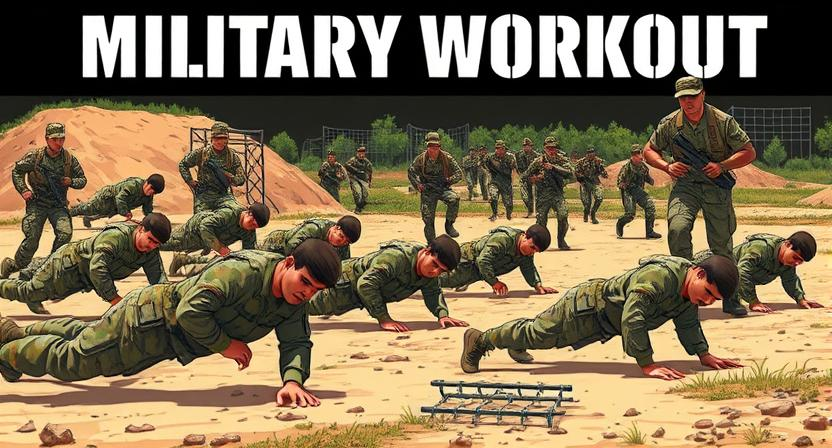Military Workout at Home: Build Strength, Discipline, and Endurance
If you have ever been impressed by the physical fitness of some distinguished member of the military, and thought to yourself, “How do they train that way?” you are by no means the only one. Workouts within the military are nothing if not renowned for being physically demanding, efficient, and an “I-don’t-have-an-excuse” type of attitude. The best part, though? You do not need a gym, special equipment, or even a drill sergeant yelling and barking orders in your ear to conduct them. A military workout at home will dramatically improve your strength, endurance, and mindset, whether you complete your routine in your living room, backyard, or a studio apartment.
However, unlike commercial fitness routines, a military workout routine is designed to build more than just a strong body, rather it promotes the discipline and mental toughness required to push past what you think your body can go. For that reason, athletes, fitness enthusiasts, and complete beginners are moving toward military workouts at home in order to build a lean and powerful physique.
This article will breakdown everything you need to know starting with military calisthenics and conditioning exercises, to workout programs you can follow. If your goal is to lose fat, build muscle, or simply train like a soldier without stepping into a gym, this article will provide you with the tools and framework to workout at home.

Introduction to Military Workouts
What is the definition of Military Workout Routine?
A military workout routine is a regimented workout plan inspired by training soldiers in boot camp and during active duty. While the classic workout guidelines are certified as effective, military workouts specialize in functional strength, muscular endurance, and cardiovascular capacity with an emphasis on mental toughness.
The concept here is quite straightforward: push-up, pull-ups, sit-ups, squats, lunges, running, and military press variations. These are the identical motions used by soldiers to prepare for the rigors of combat, fieldwork, and extended missions. Depending on your workout level, you can increase or decrease one to a five-dollar bill for the workout.
What makes a military workout great is its simplicity and effectiveness. A military workout does not require long and/or complicated machines or weights. It focuses on bodyweight calisthenics, high-intensity circuits, and conditioning lesser deconstructed than machines could devise. Looping exercises that can be done anywhere further separates this workout from the average gym workout step.
Reasons for the Popularity of Military Workouts for Home Fitness
So, why are military workouts for home fitness so popular today? The answer is threefold: convenience, efficiency, and results.
Convenience: Not everyone has time to go to a gym because of the busy lives we lead. Military style workouts at home allow you to train whenever and wherever you choose without worrying about a gym membership or having workout equipment.
Efficiency: Military workouts incorporate strength training, cardio, and endurance training within a single workout. This means, instead of spending hours on different machines, you can experience a full body workout in less than an hour.
Results: People are tired of fitness routines with “fluff”. Military workouts are raw, tough, and proven. They are the way soldiers train for a reason – they are effective in real life settings.

So, if you ever wanted a military workout regimen to achieve serious results without wasting time in the gym, home fitness might just be the solution you have been looking for.
Military Workouts and the Philosophy Behind them
A military workout is not just about sweating through push-ups and burpees. There is more to a military workout than just a set of exercises. The military exercise philosophy encompasses physical resilience as well as mental strength. Let’s break this down.
Mental Fortitude and Discipline
Soldiers are taught to continue on, regardless of how fatigued and sore they feel. This is what separates military workouts from other workouts. When you train at home using this mentality, you are not simply building muscle; you are building mental fortitude.
There is nothing like holding a plank when your arms are shaking or doing your last 10 push-ups after you are already fatigued. This is where discipline comes into the equation. Discipline, once developed in fitness component becomes transferable into every other component of life from work to achieving your own goals.
Physical Strength and Endurance
A military calisthenics workout promotes not just raw strength, but also endurance that endures over time. For example, push-ups build upper body power, squats build leg drive, and burpees build your stamina. You will not just notice you are bigger or stronger over time, but you can also go faster for longer.
Contrarily, bodybuilding programs isolate muscles to be targeted individually. Military workouts target your body as one working system; this ensures you are not just strong in the gym environment; you are strong in life.
The Importance of Consistency in Military Workouts
The most difficult aspect of fitness is not the workout itself but completing the workout consistently. As with all military-oriented training, it is built around routine and consistency. So even if you are doing a 100 military workout plan at home, the goal is to simply show up everyday, take excuses out of the equation, and put in the work.
Think about it like building armor, piece at a time. Each day you complete your military workout at home, you stack and add another piece of armor which works to making you tougher, stronger, and bulletproof.
What do You Get from Doing Military Workouts at Home?
So besides getting a fitter body, what do you gain from doing some sort of military workout routine at home? You gain more than that – you gain an entirely different lifestyle.
No Equipment Needed
One of the most appealing features of doing military workouts at home, is that you are virtually equipment free. Push-ups, squats, sit-ups, lunges, burpees – your body is the gym.
It’s true that pull-up bars or resistance bands can be helpful, but they’re not essential. You can do towel rows instead of pull-ups, or use a chair to do dips—whatever you have available. That’s why this is one of the easiest workout routines available, for everyone—there’s no excuse!

Full-Body Workouts and Fat Loss
Military-style training is all about trying to challenge your whole body all at once. A traditional gym setting doesn’t allow you to work multiple muscle groups in one exercise. When you start to build strength using military-style exercise techniques, you’ll also utilize more calories than a traditional gym setting.
For instance, a series of push-ups, squats, burpees, and mountain climbers, would hit your arms, legs, chest, and core—all while raising your heart rate. Over time, this will assist you with reducing body fat, building muscle definition, and overall conditioning.
Functional Fitness and Strength for Real Life
The biggest difference between military fitness and working out in a gym is functionality. Soldiers don’t train just to look good—soldiers train to be able to perform tasks in their uniform and on their mission. That means they have to be able to carry heavy loads, run short distances, climb things, and remain upright for a long day.
A military-style calisthenics workout helps build the fitness you’ll use daily. You’ll have energy and stamina for things like carrying groceries from your car to your house, or chasing after your children.
Key Elements of a Military Workout Routine
Before you get into push-ups and burpees, it’s important to consider the critical elements of a military workout program. These four elements are the basis of every session.
Warm-Up and Mobility
Every military workout begins with a dynamic warm-up. Think jumping jacks, arm circles, high knees, and light jogging in place. While warming up, you are not simply loosening up. You are preparing your body and mind for the task at hand—potentially high-volume and high-intensity work.
Not warming up is similar to when you start your car on a winter day without allowing it to warm up first. You risk injury, reduce performance, or both. A good 10-minute warm-up will help prime your muscles and joints and cardiovascular system for the task at hand.
Strength Training Considerations
Strength in the military is about mastery of bodyweight exercise and progressive overload. That means push-ups, pull-ups, dips, and more of the bulk of strength and conditioning work. Over time you develop greater volumes of the exercise, develop variations, or even add to your bodyweight (such as loading a backpack with books).
But unlike a gym-based workout that isolates muscles, military work remains compound. This means that more muscles are being activated through a movement, which typically increases the rate of strength development as opposed to isolating muscle or muscle groups.
Cardiovascular Exercise and Conditioning
Running is a key component of the military training style used for their training, but at home you can easily swap running for burpees or some jump rope or by using a high intensity circuit form of training. The idea is to build a heart that can sustain a long amount of time along with the heart to handle the short duration of time of burst intensity exercise. Conditioning drills like mountain climbers, sprint intervals, or shuttle runs can replicate the random intensity bouts that soldiers are challenged to cope with when dealing with a real life unpredictable soldier condition.
Core and Stability Work
Beyond having a six pack abs, the core is foundational to basic movement. Planks, leg lifts, flutter kicks and Russian twists are essential to any military workout routine. A solid core not only improves posture and reduces the occurrence of injury, but improves every push up, pull up or squat exercise you execute.
Military Calisthenics Workout for Home
If you ever thought to yourself, “Can I really build strength through just using bodyweight training?” the answer is a resounding positive. A military calisthenics workout is proof that bodyweight exercises are the only things needed to build strength endurance and muscle definition.
Push-Up Variations
Push-ups are fundamental exercises in military fitness. However, there is much more to push-ups than perhaps you have experienced with the traditional push-up. Soldiers may use variations of the standard push-up such as
Wide-arm push-ups (focus on chest)
Diamond push-ups (focus on triceps and shoulders)
Decline push-ups (focus on upper chest)
Clap push-ups (explosive movement)
When you work out at home, you can create different workouts by going through these push-up variations to add complexity and challenge to your workouts.
Pull-Ups and Alternatives
Pull-ups are gold standards for upper body strength. But you can do pull-ups at home, if you do not have a bar, using:
Towel rows on a door frame
Row your own backpack with weight
Resistance bands as pull-downs
No excuses—you can always find a way to mimic this pulling movement.
Bodyweight Squats and Lunges
Legs are important in a military workout. Squats, jump squats, lunges and Bulgarian split squats build strength in your legs, as well as balance and stability.
Want to get more intense? Add a backpack full of books, or hold water jugs while you’re squatting.
Burpees and High-Intensity Drills
People hate burpees for a reason—because they’re incredibly effective. Burpees achieve strength, cardio and explosiveness in one movement. This is the main reason why soldiers have to complete burpees–to build endurance while fatigued, and you can do them too.
Pairing burpees with mountain climbers, sprints, and jumping jacks will give you a crazy heart pounding military calisthenics workout right in the comfort of your own home.
Sample Workout Plan (Military Style) of 100 (Beginner-Friendly)
One of the best ways to get into a military style of training is to use a 100 military style workout plan. The reason this concept excites people is that it is simply to achieve 100 total hats of relatively basic exercises every day. You can manage the volume any way you like; you can complete the entire 100 repetitions at once or in smaller sets, it is up to you depending on your level of fitness. The important thing is that you are developing discipline, taking yourself to another place in terms of strength and endurance abilities.
Below is a sample routine that is 4 days in length that you can easily do from home:
Day 1 – Upper Body
100 pushups (break into 10×10 if necessary)
50 pullups or rows (use alternative if no bar is available)
3 sets of dips on a chair
This is day is the ultimate builder of chest, shoulders and overall arm strength. Allow for minimal rest but aim to complete your total reps.
Day 2 – Lower Body
100 bodyweight squats
50 lunges per leg
50 jump squats
On this day you will focus on developing strong legs that will carry you through anything. If 100 reps sounds too much then start with 50 and build up.
Day 3 – Core & Conditioning
– 100 sit-ups or crunches
– 50 flutter kicks
– 3 minute plank hold
– 20 burpees
It’s going to get those abs firing and build some real endurance. Burpees give you that added conditioning punch that soldiers will swear by.
Day 4 – Active Recovery
Even the military recognizes recovery is just as important as working out. Doing some light stretching, yoga, or even some brisk walking for 30 minutes will do. Your body needs that time to rebuild, so don’t skip it.
This simple 100 military workout plan is highly effective. Stick with it for 30 days and you’ll notice stronger muscles, better stamina, and an improved mindset.
Advanced Military Workout Program
Once you’ve developed your skills with the basics, you’ll want to step it up with an advanced military workout program. These advanced programs will push you beyond your comfort zone with increased repetitions, higher level movements, and added weight.
High-Rep Endurance Circuits
An advanced soldier does 200-300 push-ups, 100+ pull-ups, and runs for miles in a day. At home, we can simulate that intensity with circuits like:
50 push-ups
20 pull-ups or rows
30 squats
10 burpees
Repeat the circuit 4-6 times with little rest. Here, we focus on endurance under fatigue, the main difference between military workouts and normal fitness workouts.
Weight-Based Training
No dumbbells? No problem! Use a backpack filled with books or bottles of water to add weight. You can perform:
Weighted squats
Push-ups with the backpack (rest the bag on the back)
Overhead presses (simulating a military press)
Farmer’s walks with heavy bags
This provides some weight training, while also adding the element of functional movement and helps build raw strength.
Military Press and Building Strength
The military press is a well-known overhead press that strengthens the shoulder and upper back. You can do this move with dumbbells, resistance bands, or anything from around the house like a water jug filled with water.
To progress it is simple:
Start with a lighter weight focusing on form.
Add more reps or weight slowly.
Play with variations like a seated press or push press.
Eventually, this motion will provide you with the same strong, square shoulders soldiers are known for.
Military Workouts for Weight Loss
While people often think of strength building, military workouts are also a sound way to lose body fat. By combining strength training, cardio, and high-intensity movement, in this combination you will find one of the best ways to lose body fat.
High-Intensity Calisthenics for Weight Loss
Burpees, squat jumps, mountain climbers, push-up circuits. These types of exercises keep your heart pumping at peak levels as you burn calories away. For fat loss, you want to do short bursts of intense activity like the following:
30 seconds burpees
30 seconds push ups
30 seconds squats
30 seconds mountain climbers
Rest for 1 minute then repeat 5 times!
Training this way will be much more effective for fat loss than going for long periods of cardio.
Nutrition for Fat Loss
You can’t have a workout plan, period, without good nutrition practices. Soldiers use simple, balanced meal deals to maintain energy. When your focus is fat loss, think about the following:
Lean proteins- Chicken, fish, eggs, beans
Whole carbs- Brown rice, oats, sweet potatoes
Healthy fats- avocado, nuts, olive oil,
Lots of vegetables and water
Stay clear of sugary snacks, sodas, and junk food. Weight loss is 70% diet and 30% exercise, do not allow your diet to ruin the good work you just put in.
Military Workouts vs. Gym Workouts
People constantly ask if they should only be doing workouts from a military program, or should they go to the gym. There are definitely upsides of both, but they are completely different types of workouts.
Which is More Effective?
If your target is functional fitness, fat loss, and overall strength, it’s probably a better idea to follow a military workout program at home. When the goal is aesthetic or overall muscle mass gains, the gym situation will provide you with equipment more specialized towards that goal.
Think about it like this:
Military training = functional strength, endurance, and toughness
Gym training = muscle size, isolated moves, and regimented progression
Good and Bad about each approach
Military Workouts at Home are:
✅ No equipment required
✅ Builds mental toughness
✅ Can acheive “full body” training in less time
❌ Minimal isolation of muscles
❌ Progression will be slower (or harder) than with weights
Gym Training is:
✅ Use of equipment, variety, and range of motion is easy
✅ Easier to achieve muscle mass-gains
✅ Available program can be taken the guesswork and work from program design
❌ Time and money loss
❌ Not a mental challenge
In the end, the best program is going to be one of consistency. Some traineers even combine the two to create maximum outputs.
Women’s Military Workout Routines
Military-style workouts do not cater only to men; women are just as capable of using these workouts. It helps build lean muscle, burn fat, and build the type of strength you can use in your everyday life, more so than other types of workouts.
Beginners’ Modifications
If you are a beginner, you will not need to worry about completing military standards of high reps. You can do modified versions of:
Push-ups on your knees, or push-ups against the wall
Pull-ups with an assisted band
Bodyweight squats versus jump squats
Shorter holds of the plank
The idea is to build confidence and strength over time, rather than worrying about getting hurt.
Build Lean Strength at Home
Over time, you will be able to progress into full push-ups, pull-ups, and a weighted squat. The great thing with military workouts is that it tones muscles, not makes them bulky. This means you can develop a leaner, more athletic look, while building stamina and confidence.
Training at home with military workouts means no gyms are too intimidating when being in a crowded gym, just you, your body, and the workout process.
Common Errors in Military Style Fitness
Military-style workouts are effective, but only if performed appropriately. Too many beginners (and even some experienced trainees) make simple errors that can not only slow down their progress but slow down progress and lead to injuries. It’s just as important to know what not to do – you’re just as likely to run into trouble – and keep you from meeting your goals.
Over Work, Not Recovery
You can get into trouble with your military workout if you are always working too hard without recovery. Having signed your name in blood to your performance, your body still requires recovery to repair itself and improve your strength and performance.
A soldier trains every day, but typically folks are not playing it out this way. Anyone can put in daily push-ups, burpees or squats in an unbalanced way, followed by another day of unbalanced training, followed by another. Before you know it, you are burned out physically and mentally.
Solution:
Train smarter and not only hard
Training should include at least one active recovery day one day (light yoga, walking with some light stretching).
Listen to your body- if you have constant pain or exhaustion, take a day off!
Inferior Posture and Injury Risk
Another common mistake that individuals make is compromising their form for speed, or maxing out reps performed. Doing a half push-up, a squat with a knee bend, or performing a swinging pull-up can feel more comfortable and easier in some cases; however, at the same time, marginalizing form does not yield the benefits of the exercise and can possibly lead to injuries.
To put into context, think about training similar to a military organization or the building of a house. If the foundation (the form) of the building is not developed properly, the house will collapse. Always focus on the quality of movement before the quantity.
Ways to Improve Your Form
Utilize a mirror for check your form.
Utilize short videos of your workout, for checking form later.
Slow down; slow movements create better controlled movements.
How to Stay Motivated to Train Institutionally from Home
Motivation is typically the hardest part of any workout routine, particularly if at home when it is easy to distract yourself from a workout. This is why easily developing a military mindset is key to maintaining consistent training.
Goal Setting and Tracking I Improvements
The military do not just engage in random “workouts,” they train with direction and purpose; therefore, you should also have intention, purpose and tracking of your motivations. Good and clear goal setting as a source of tracking your motivation and purpose.
Some uncomplicated and measurable aims include:
Performing 50 push-ups in a row without stopping.
Running 2 miles in 15 minutes or less.
Holding a plank for 5 minutes.
Make sure to write out your goals and keep track of your progress weekly! Nothing motivates you more than being able to see measurable evidence of improvement!
Discipline-Mindset Building
Motivation is short-term. Discipline is long-term. Military training always comes down to showing up, despite how you feel about it. At home, that meant developing a routine and sticking to it, regardless of the emotional and mental barriers that might be present.
Here are some ways to build your discipline:
Train at the same time every day.
Designate a workout space at home.
Remind yourself every day of why you started.
Always remember—motivation gets you started, but discipline gets you results.
Common Questions About Military Workouts
Q1: Can novice individuals perform military workouts at home?
Absolutely! You can begin with the basic exercises, such as push-ups, squats, and planks. If you need to modify the exercise, please do so, and you can gradually increase the repetitions.
Q2: How many days a week should I train?
We recommend training 4-5 days a week with at least one rest or active recovery day.
Q3: Do I need any equipment to do military workouts?
No! the majority of the routines are bodyweight only. If you want to have a little substitute, you can use equipment (like pull-up bars or resistance bands) for variety.
Q4: How long should the workout be?
Workouts can be 30-60 minutes, depending on your intensity and goals.
Q5: Will military workouts help me to lose weight?
Definitely. By using a combination of strength and cardio, you’ll burn fat and build lean muscle at the same time. Pair your workouts with a balanced diet for the best results.
Final thoughts
You don’t need to join a boot camp, get a gym membership, or buy expensive equipment to train like a soldier. A military workout at home would be enough to develop your body, sharpen your mind, and foster unbreakable discipline. Military calisthenics workouts and planned exercise routines, such as the 100 military workout plan, can be completed anywhere at any time.
The most important thing is consistency. Commit to the program, work through the excuses, and work toward both physical and mental development. Ultimately, every push-up, squat, and burpee is not just a workout; it’s one step closer to being the strongest version of yourself.
So dust off your workout mat, put on your shoes, and get started today. The soldier mindset is ready for you – in your own home!



